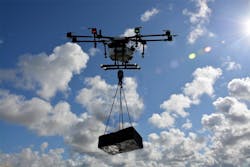Wanted: heavy-lift uncrewed aircraft able to fly 35-ton shipping containers from ships to invasion beaches
ARLINGTON, Va. – U.S. military researchers are considering asking industry to develop heavy-lift uncrewed aerial vehicles (UAVs) able to fly loads equal to that of a fully loaded 747 cargo jet or loaded 18-wheel commercial freight truck.
Officials of the U.S. Defense Advanced Research Projects Agency (DARPA) in Arlington, Va., issued a request for information (DARPA-SN-24-109) in September for the Cost Efficient Cargo project to develop heavy-lift UAVs able to lift 35-ton payloads using commercial off the shelf (COTS) engines and drive train technology. 35 tons weighs 70,000 pounds.
Armed forces must move troops, vehicles, and supplies from naval vessels to beachheads, and then across terrain and obstacles; any delays can expose forces to enemy fire and hinder establishing secure footholds.
Heavy-lift UAVs could transport equipment, supplies, and large platforms in bad weather and avoid enemy defenses effectively. Using heavy-lift UAVs could help maintain operational speed, reduce vulnerability to attack, and ensure continuous logistical support.
Related: Volocopter unveils its heavy-lift VoloDrone
The Sikorsky CH-53K King Stallion today is the American helicopter with the highest payload capacity at 36,000 pounds and serves as the U.S. Marine Corps primary heavy-lift helicopter. Developing crewed helicopters with greater lifting capacity is limited rotor design, power-to-weight ratio, airframe strength, vibration and stress, and crew safety.
UAVs, on the other hand, could offer innovation in design and greater mission profile flexibility, without the cost of crewed safety considerations, and reduce training and certification time for pilots.
DARPA researchers are looking for leap-ahead enabling technologies, and say they are not interested in incremental improvements, derivatives of standard helicopters, multirotor copters, tail sitters, or jump platforms with wing kits. There are no restrictions on internal vs external cargo.
The bottom line is that the U.S. needs to move large and heavy cargo cheaply, DARPA researchers point out. Examples are moving 40-foot transport containers to invasion beaches from ships located 10 miles offshore.
DARPA also is interested in identifying design insights and key risks that can be addressed within a scaled-down form to substantiate additional military investment in heavy-lift systems.
From industry, DARPA wants information on the design and maneuverability, mission profile, costs, scalability, and ranges of potential heavy-lift UAV designs. These future large cargo UAVs would be able to fly 70,000-pound payloads over 25 miles at 500-foot altitudes, detach payloads, and return to base. Submissions should consider 10,0000-, 30,000-, and 45,000-pound payloads able to operate at ranges of 10, 25, 50, and 100 miles. Inexpensive, technically acceptable small-scalable versions may help prove concepts.
Companies interested should email concise white papers no later than 20 Dec. 2024 to DARPA at [email protected]. Email questions or concerns to [email protected]. More information is online at https://www.fbodaily.com/archive/2024/09-September/25-Sep-2024/FBO-07220784.htm.
About the Author
John Keller
Editor-in-Chief
John Keller is the Editor-in-Chief, Military & Aerospace Electronics Magazine--provides extensive coverage and analysis of enabling electronics and optoelectronic technologies in military, space and commercial aviation applications. John has been a member of the Military & Aerospace Electronics staff since 1989 and chief editor since 1995.
